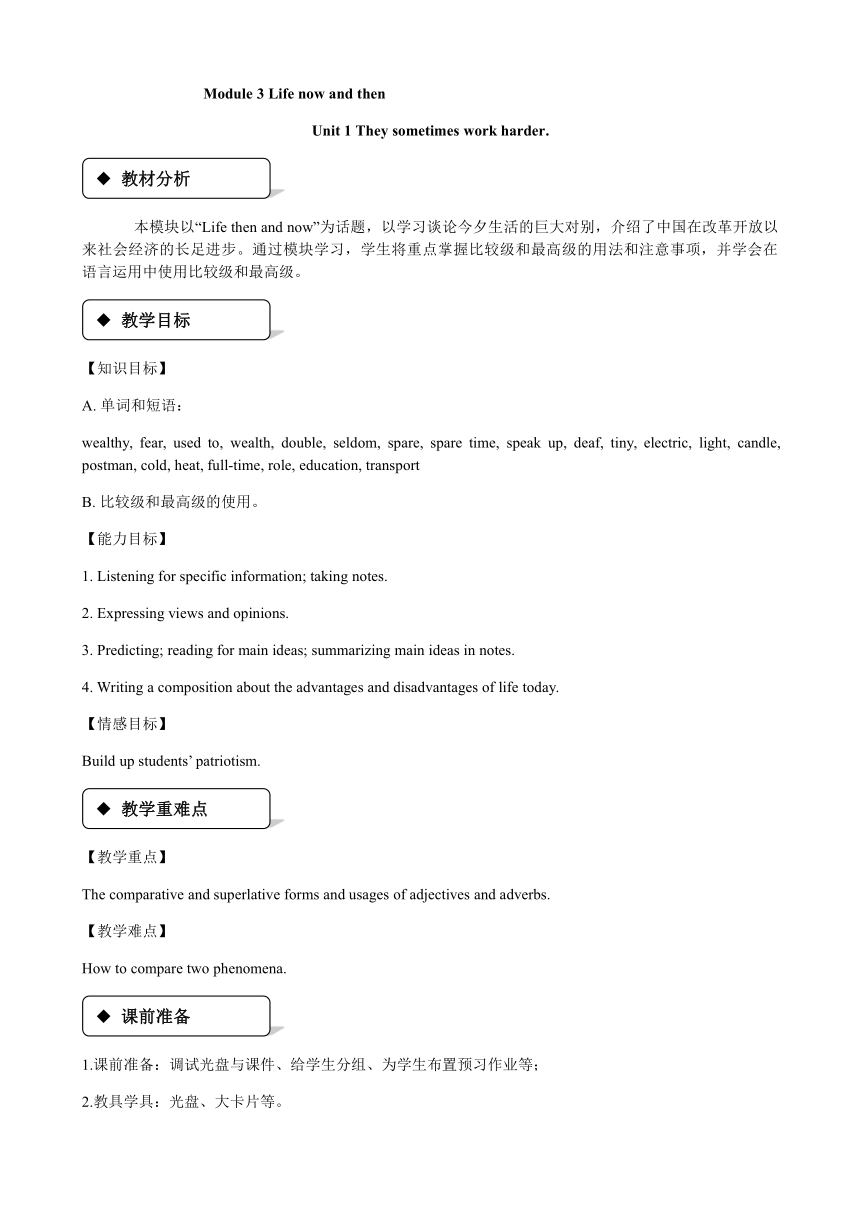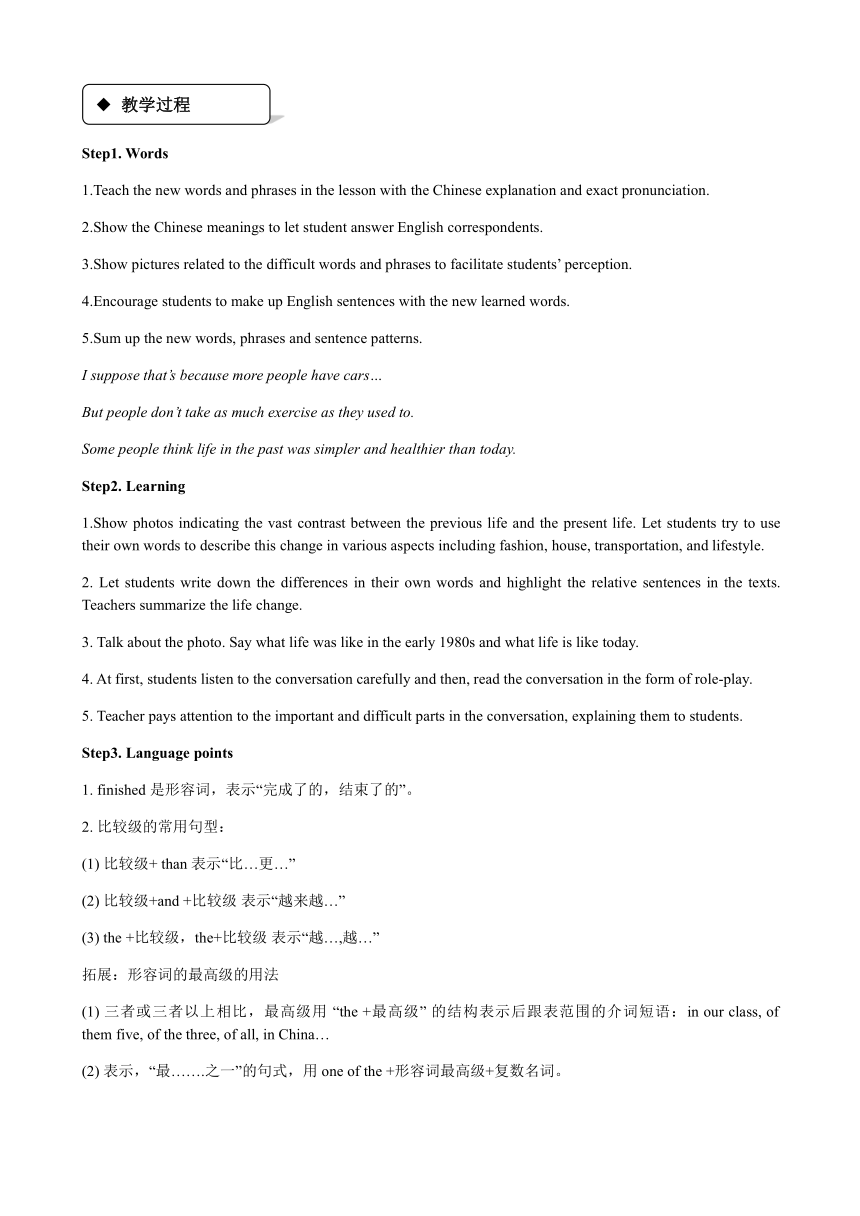外研版英语九年级下册Module 3 Unit 1 They sometimes work harder 教案
文档属性
| 名称 | 外研版英语九年级下册Module 3 Unit 1 They sometimes work harder 教案 |  | |
| 格式 | docx | ||
| 文件大小 | 14.2KB | ||
| 资源类型 | 教案 | ||
| 版本资源 | 外研版 | ||
| 科目 | 英语 | ||
| 更新时间 | 2023-05-25 08:25:14 | ||
图片预览


文档简介
Module 3 Life now and then
Unit 1 They sometimes work harder.
(
教材分析
)
本模块以“Life then and now”为话题,以学习谈论今夕生活的巨大对别,介绍了中国在改革开放以来社会经济的长足进步。通过模块学习,学生将重点掌握比较级和最高级的用法和注意事项,并学会在语言运用中使用比较级和最高级。
(
教学目标
)
【知识目标】
A. 单词和短语:
wealthy, fear, used to, wealth, double, seldom, spare, spare time, speak up, deaf, tiny, electric, light, candle, postman, cold, heat, full-time, role, education, transport
B. 比较级和最高级的使用。
【能力目标】
1. Listening for specific information; taking notes.
2. Expressing views and opinions.
3. Predicting; reading for main ideas; summarizing main ideas in notes.
4. Writing a composition about the advantages and disadvantages of life today.
【情感目标】
Build up students’ patriotism.
(
教学重难点
)
【教学重点】
The comparative and superlative forms and usages of adjectives and adverbs.
【教学难点】
How to compare two phenomena.
(
课前准备
)
1.课前准备:调试光盘与课件、给学生分组、为学生布置预习作业等;
2.教具学具:光盘、大卡片等。
(
教学过程
)
Step1. Words
1.Teach the new words and phrases in the lesson with the Chinese explanation and exact pronunciation.
2.Show the Chinese meanings to let student answer English correspondents.
3.Show pictures related to the difficult words and phrases to facilitate students’ perception.
4.Encourage students to make up English sentences with the new learned words.
5.Sum up the new words, phrases and sentence patterns.
I suppose that’s because more people have cars…
But people don’t take as much exercise as they used to.
Some people think life in the past was simpler and healthier than today.
Step2. Learning
1.Show photos indicating the vast contrast between the previous life and the present life. Let students try to use their own words to describe this change in various aspects including fashion, house, transportation, and lifestyle.
2. Let students write down the differences in their own words and highlight the relative sentences in the texts. Teachers summarize the life change.
3. Talk about the photo. Say what life was like in the early 1980s and what life is like today.
4. At first, students listen to the conversation carefully and then, read the conversation in the form of role-play.
5. Teacher pays attention to the important and difficult parts in the conversation, explaining them to students.
Step3. Language points
1. finished 是形容词,表示“完成了的,结束了的”。
2. 比较级的常用句型:
(1) 比较级+ than 表示“比…更…”
(2) 比较级+and +比较级 表示“越来越…”
(3) the +比较级,the+比较级 表示“越…,越…”
拓展:形容词的最高级的用法
(1) 三者或三者以上相比,最高级用 “the +最高级” 的结构表示后跟表范围的介词短语:in our class, of them five, of the three, of all, in China…
(2) 表示,“最…….之一”的句式,用one of the +形容词最高级+复数名词。
比较级与最高级的修饰语应置于其所修饰的形容词或者副词之前。
常见的比较级的修饰语有:much, still, a lot, even, far。
比较级与最高级的修饰语应置于其所修
饰的形容词或者副词之前。
常见的比较级的修饰语有:much, still, a lot, even, far.
3. deal with意思是“处理;安排;对付 ”,常与疑问副词how搭配使用。
4.形容词原级
as…as… 同级比较,否定句可以用not so/as…as...表示。as…as, not so…as中间用形容词、副词原级。
5. used to 指的是过去的习惯性动作,目的在于与现在形成对照。used to do sth. 指的是“过去常常做某事”,但是现在不做了。
对比be used to 被用来做;
be /get used to doing表示习惯于做某事。
6. suppose在这里是一个动词, 意为“猜想, 认为”, 后面可以接that引导的宾语从句, 此时注意对宾语从句的否定要移到主句上来。
7. Everyday English
Nearly finished.
That’s true.
I suppose…
Step4. Practice
After reading the conversation, students choose the most appropriate one out of four options.
Step5. Homework
1. Finish the exercises in the workbook.
2. Think about:
Is our life better than in the past
Give examples, such as buildings, transport, environment and so on.
(
教学反思
)
无
Unit 1 They sometimes work harder.
(
教材分析
)
本模块以“Life then and now”为话题,以学习谈论今夕生活的巨大对别,介绍了中国在改革开放以来社会经济的长足进步。通过模块学习,学生将重点掌握比较级和最高级的用法和注意事项,并学会在语言运用中使用比较级和最高级。
(
教学目标
)
【知识目标】
A. 单词和短语:
wealthy, fear, used to, wealth, double, seldom, spare, spare time, speak up, deaf, tiny, electric, light, candle, postman, cold, heat, full-time, role, education, transport
B. 比较级和最高级的使用。
【能力目标】
1. Listening for specific information; taking notes.
2. Expressing views and opinions.
3. Predicting; reading for main ideas; summarizing main ideas in notes.
4. Writing a composition about the advantages and disadvantages of life today.
【情感目标】
Build up students’ patriotism.
(
教学重难点
)
【教学重点】
The comparative and superlative forms and usages of adjectives and adverbs.
【教学难点】
How to compare two phenomena.
(
课前准备
)
1.课前准备:调试光盘与课件、给学生分组、为学生布置预习作业等;
2.教具学具:光盘、大卡片等。
(
教学过程
)
Step1. Words
1.Teach the new words and phrases in the lesson with the Chinese explanation and exact pronunciation.
2.Show the Chinese meanings to let student answer English correspondents.
3.Show pictures related to the difficult words and phrases to facilitate students’ perception.
4.Encourage students to make up English sentences with the new learned words.
5.Sum up the new words, phrases and sentence patterns.
I suppose that’s because more people have cars…
But people don’t take as much exercise as they used to.
Some people think life in the past was simpler and healthier than today.
Step2. Learning
1.Show photos indicating the vast contrast between the previous life and the present life. Let students try to use their own words to describe this change in various aspects including fashion, house, transportation, and lifestyle.
2. Let students write down the differences in their own words and highlight the relative sentences in the texts. Teachers summarize the life change.
3. Talk about the photo. Say what life was like in the early 1980s and what life is like today.
4. At first, students listen to the conversation carefully and then, read the conversation in the form of role-play.
5. Teacher pays attention to the important and difficult parts in the conversation, explaining them to students.
Step3. Language points
1. finished 是形容词,表示“完成了的,结束了的”。
2. 比较级的常用句型:
(1) 比较级+ than 表示“比…更…”
(2) 比较级+and +比较级 表示“越来越…”
(3) the +比较级,the+比较级 表示“越…,越…”
拓展:形容词的最高级的用法
(1) 三者或三者以上相比,最高级用 “the +最高级” 的结构表示后跟表范围的介词短语:in our class, of them five, of the three, of all, in China…
(2) 表示,“最…….之一”的句式,用one of the +形容词最高级+复数名词。
比较级与最高级的修饰语应置于其所修饰的形容词或者副词之前。
常见的比较级的修饰语有:much, still, a lot, even, far。
比较级与最高级的修饰语应置于其所修
饰的形容词或者副词之前。
常见的比较级的修饰语有:much, still, a lot, even, far.
3. deal with意思是“处理;安排;对付 ”,常与疑问副词how搭配使用。
4.形容词原级
as…as… 同级比较,否定句可以用not so/as…as...表示。as…as, not so…as中间用形容词、副词原级。
5. used to 指的是过去的习惯性动作,目的在于与现在形成对照。used to do sth. 指的是“过去常常做某事”,但是现在不做了。
对比be used to 被用来做;
be /get used to doing表示习惯于做某事。
6. suppose在这里是一个动词, 意为“猜想, 认为”, 后面可以接that引导的宾语从句, 此时注意对宾语从句的否定要移到主句上来。
7. Everyday English
Nearly finished.
That’s true.
I suppose…
Step4. Practice
After reading the conversation, students choose the most appropriate one out of four options.
Step5. Homework
1. Finish the exercises in the workbook.
2. Think about:
Is our life better than in the past
Give examples, such as buildings, transport, environment and so on.
(
教学反思
)
无
同课章节目录
- Module 1 Travel
- Unit 1 We toured the city by bus and by taxi
- Unit 2 It's a long story.
- Unit 3 Language in use
- Module 2 Education
- Unit 1 They don't sit in rows.
- Unit 2 What do I like best about school?
- Unit 3 Language in use
- Module 3 Life now and then
- Unit 1 They sometimes work harder.
- Unit 2 I think life is better today.
- Unit 3 Language in use.
- Module 4 Rules and suggestions
- Unit 1 You must be careful of falling stones.
- Unit 2 we must keep the camp clean.
- Unit 3 Language in use.
- Revison A
- Module 5 Look after yourself
- Unit 1 We'd better get you to hospital.
- Unit 2 Get off the sofa!
- Unit 3 Language in use.
- Module 6 Eating togethe
- Unit 1 When is the school-leavers' party?
- Unit 2 Knives and forks are used for most Western
- Unit 3 Language in use
- Module 7 English for you and me
- Unit 1 Have you ever been to an English corner?
- Unit 2 We all own English.
- Unit 3 Language in use
- Module 8 My future life
- Unit 1 Here's to our friendship and the future
- Unit 2 I know that you will be better at maths.
- Unit 3 Language in use
- Revison B
